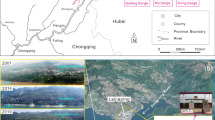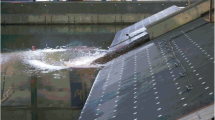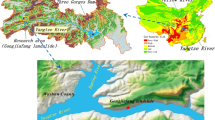Abstract
Subaerial landslides falling into confined water bodies often generate impulsive waves. Damaging landslide tsunamis in Three Gorges Reservoir, China, have struck several times in the last 15 years. On June 24, 2015, a 23 × 104 m3 slope failure occurred on the east bank of the Daning River opposite Wushan Town. The sliding mass intruded into the Three Gorges Reservoir and initiated a reservoir tsunami that resulted in two deaths and significant damage to shipping facilities. A post-event survey revealed the landslide geometry and wave run-up distribution, while an eyewitness video captured most of the landslide motion. Employing these firm constraints, we applied the Tsunami Squares method to simulate the 2015 Hongyanzi landslide and tsunami. The simulation revealed that the landslide experienced a progressive failure in the first few seconds and impacted the water with a maximum velocity of ~ 16 m/s. The initial wave propagated to the opposite shore in an arch shape, and the water surface reached a maximum amplitude of ~ 11 m near the landslide. Wave amplitude-time curves at four points on the river cross section show that the initial wave reached Wushan town in about 50 s with an average wave velocity of ~ 30 m/s. The maximum wave run-ups on the shoreline opposite the landslide are around 6 m and attenuate to less than 1 m beyond 2-km distance. The landslide simulation matches the observed geological profile and the eyewitness video, and the numerical results coincide with the observed wave run-up heights. Nearly 80% of landslide energy is lost due to frictional resistances, but the remaining fraction imparted to the tsunami carried catastrophic consequences to a large region. The numerical results emphasize the efficiency and accuracy of Tsunami Squares method for a “Quick Look” simulation of a potential landslide.














Similar content being viewed by others
References
Ataie-Ashtiani B, Najafi Jilani A (2007) A higher-order Boussinesq-type model with moving bottom boundary: applications to submarine landslide tsunami waves. Int J Numer Methods Fluids 53:1019–1048
Ataie-Ashtiani B, Najafi-Jilani A (2008) Laboratory investigations on impulsive waves caused by underwater landslide. Coast Eng 55:989–1004
Ataie-Ashtiani B, Nik-Khah A (2008) Impulsive waves caused by subaerial landslides. Environ Fluid Mech 8:263–280
Ataie-Ashtiani B, Yavari-Ramshe S (2011) Numerical simulation of wave generated by landslide incidents in dam reservoirs. Landslides 8:417–432
Bregoli F (2015) Tsunami provoked by fast granular landslides: 3D laboratory experiments on generation and initial propagation of waves. Dissertation. Polytechnic University of Catalonia, UPC
Dai FC, Deng JH, Tham LG, Law KT, Lee CF (2004) A large landslide in Zigui County, Three Gorges area. Can Geotech J 41:1233–1240
Dutykh D, Kalisch H (2013) Boussinesq modeling of surface waves due to underwater landslides. Nonlinear Process Geophys 20:267–285
Enet FO, Grilli ST (2007) Experimental study of tsunami generation by three-dimensional rigid underwater. Landslides 133:442–454
Fritz H M (2002) Initial phase of landslide generated impulse waves. Dissertation. Swiss Federal Institute of technology (ETH)
Fritz HM, Hager WH, Minor HE (2003a) Landslide generated impulse waves. 1 Instantaneous flow fields. Exp Fluids 35:505–519
Fritz HM, Hager WH, Minor HE (2003b) Landslide generated impulse waves. 2. Hydrodynamic impact craters. Exp Fluids 35:520–532
Fritz HM, Hager WH, Minor HE (2004) Near field characteristics of landslide generated impulse waves. J Waterw Port Coast Ocean Eng 130:287–302
Grilli ST, Watts P (2005) Tsunami generation by submarine mass failure. I: modeling, experimental validation, and sensitivity analyses. J Waterw Port Coast Ocean Eng 131:283–297
Grilli ST, Shelby M, Kimmoun O, Dupont G, Nicolsky D, Ma G, Kirby JT, Shi F (2017) Modeling coastal tsunami hazard from submarine mass failures: effect of slide rheology, experimental validation, and case studies off the US East Coast. Nat Hazards 86:353–391
Harbitz CB, Glimsdal S, Lovholt F, Kveldsvik V, Pedersen GK, Jensen A (2014) Rockslide tsunamis in complex fjords:from an unstable rock slope at Akerneset to tsunami risk in western Norway. Coast Eng 88:101–122
Heller V, Hager W H, Minor H E (2009) Landslide generated impulse waves in reservoirs—basics and computation. VAW Mitteilung 211, Boes, R. ed. ETH Zurich, Zurich
Heller V, Bruggemann M, Spinneken J, Rogers B (2016) Composite modelling of subaerial landslide-tsunamis in different water body geometries and novel insight into slide and wave kinematics. Coast Eng 109(3):20–41
Huang B, Yin Y, Du C (2016) Risk management study on impulse waves generated by Hongyanzi landslide in Three Gorges Reservoir of China on June 24, 2015. Landslides 13:603–616
Hungr O, Evans SG, Bovis MJ, Hutchinson JN (2001) A review of the classification of landslides of the flow type. Environ Eng Geosci 7:221–238
Liu PLF, Wu TR, Raichlen F, Synolakis C, Borrero J (2005) Runup and rundown generated by three-dimensional sliding masses. J Fluid Mech 536:107–144
Lynett P, Liu PLF (2005) A numerical study of the run-up generated by three-dimensional landslides. J Geophys Res 110:C03006
Ma G, Shi F, Kirby JT (2011) A polydisperse two-fluid model for surf zone bubble simulation. J Geophys Res 116:1–21
Ma G, Kirby JT, Shi F (2013) Numerical simulation of tsunami waves generated by deformable submarine landslides. Ocean Model 69:146–165
Ma G, Kirby JT, Hsu T, Shi F (2015) A two-layer granular landslide model for tsunami wave generation: theory and computation. Ocean Model 93:40–55
Mcfall BC, Fritz HM (2016) Physical modelling of tsunamis generated by three-dimensional deformable granular landslides on planar and conical island slopes. Proc R Soc A 472:20160052
Mcfall B C, Fritz H M, Horrillo J J, Mohammed F (2014) Tsunamis generated by 3D deformable landslides in various scenarios: laboratory experiments and numerical modeling. In: AGU Fall Meeting
Miller D J (1960) Giant waves in Lituya Bay, Alaska
Mohammed F, Fritz HM (2010) Experiments on tsunamis generated by 3D granular landslides. Adv Nat Technol Hazards Res 28:705–718
Panizzo A, De Girolamo P, Di Risio M, Maistri A, Petaccia A (2005) Great landslide events in Italian artificial reservoirs. Nat Hazards Earth Syst Sci 5:733–740
Pastor M, Herreros I, Fernández Merodo JA, Mira P, Haddad B, Quecedo M, González E, Alvarez-Cedrón C, Drempetic V (2009) Modelling of fast catastrophic landslides and impulse waves induced by them in fjords, lakes and reservoirs. Eng Geol 109:124–134
Roberts N J, McKillop R J, Lawrence M S, Psutka J F, Clague J J, Brideau M, Ward B C (2013) Impacts of the 2007 landslide-generated tsunami in Chehalis Lake, Canada. In: The second world landslide forum 6:133–140. https://doi.org/10.1007/978-3-642-31319-6_19
Romano A, Di Risio M, Bellotti G, Molfetta MG, Damiani L, De Girolamo P (2016) Tsunamis generated by landslides at the coast of conical islands: experimental benchmark dataset for mathematical model validation. Landslides 13:1379–1393
Sassa K, Dang K, Yanagisawa H, He B (2016) A new landslide-induced tsunami simulation model and its application to the 1792 Unzen-Mayuyama landslide-and-tsunami disaster. Landslides 13:1405–1419
Si P, Aaron J, McDougall S, Lu J, Yu X, Roberts NJ, Clague JJ (2018) A non-hydrostatic model for the numerical study of landslide-generated waves. Landslides 15:711–726
Wang J, Ward SN, Xiao L (2015a) Numerical simulation of the December 4, 2007 landslide-generated tsunami in Chehalis Lake, Canada. Geophys J Int 201:372–376
Wang J, Ward SN, Xiao L (2015b) Numerical modelling of rapid, flow-like landslides across 3-D terrains: a tsunami squares approach to El Picacho landslide, El Salvador, September 19, 1982. Geophys J Int 201:1534–1544
Wang W, Chen G, Zhang H, Zhou S, Liu SWY, Fan F (2016) Analysis of landslide-generated impulsive waves using a coupled DDA-SPH method. Eng Anal Bound Elem 64:267–277
Ward SN (2001) Landslide tsunami. J Geophys Res Solid Earth 106(B6):11201–11215
Ward SN, Day S (2006) Particulate kinematic simulations of debris avalanches: interpretation of deposits and landslide seismic signals of Mount Saint Helens, 1980 May 18. Geophys J Int 167:991–1004
Ward SN, Day S (2008) Tsunami balls: a granular approach to tsunami runup and inundation. Commun Comput Phys 3:222–249
Ward SN, Day S (2010) The 1958 Lituya bay landslide and tsunami—a tsunami ball approach. J Earthq Tsunami 4:285–319
Ward SN, Day S (2011) The 1963 landslide and flood at Vaiont reservoir Italy: a tsunami ball simulation. Boll Soc Geol Ital 130:16–26
Watt S, Talling PJ, Vardy ME, Heller V et al (2012) Combinations of volcanic-flank and seafloor-sediment failure offshore Montserrat, and their implications for tsunami generation. Earth Planet Sci Lett 319-320:228–240
Watts P, Grilli ST, Kirby JT, Fryer GJ, Tappin DR (2003) Landslide tsunami case studies using a Boussinesq model and a fully nonlinear tsunami generation model. Nat Hazards Earth Syst Sci 3:391–402
Watts P, Grilli ST, Tappin DR (2005) Tsunami generation by submarine mass failure. II: predictive equations and case studies. J Waterw Port Coast Ocean Eng 131:298–310
Weiss R, Fritz HM, Wunnemann K (2009) Hybrid modeling of the mega-tsunami runup in Lituya Bay after half a century. Geophys Res Lett 36:L09609
Xiao L, Ward SN, Wang J (2015) Tsunami Squares approach to landslide generated waves: application to Gongjiafang landslide, Three Gorges Reservoir, China. Pure Appl Geophys 172:3639–3654
Yavari-Ramshe S, Ataie-Ashtiani B (2016) Numerical modeling of subaerial and submarine landslide-generated tsunami waves—recent advances and future challenges. Landslides 13:1325–1368
Yin K, Jiang Q, Wang Y (2002) Numerical simulation on the movement of Xintan landslide by DDA method. Chin J Rock Mech Eng 21:959–962
Zhou J, Xu F, Yang X, Yang Y, Lu P (2016) Comprehensive analyses of the initiation and landslide-generated wave processes of the 24 June 2015 Hongyanzi landslide at the Three Gorges Reservoir, China. Landslides 13:589–601
Acknowledgments
We thank Prof. Kunlong Yin in China University of Geosciences (Wuhan) for proper instructions, and we also thank the Geo-Hazard prevention authority of Chongqing for providing the valuable field survey data. The paper is supported by the Shaanxi Natural Science Fund [grant no. 2017JQ4010 and 2018JQ4041], National Science Foundation of China [grant no. 41502278], and China Postdoctoral Science Foundation [grant no. 2017M613033].
Author information
Authors and Affiliations
Corresponding author
Rights and permissions
About this article
Cite this article
Xiao, L., Wang, J., Ward, S.N. et al. Numerical modeling of the June 24, 2015, Hongyanzi landslide generated impulse waves in Three Gorges Reservoir, China. Landslides 15, 2385–2398 (2018). https://doi.org/10.1007/s10346-018-1057-2
Received:
Accepted:
Published:
Issue Date:
DOI: https://doi.org/10.1007/s10346-018-1057-2




